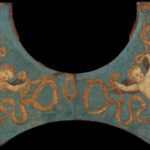Signorelli, Luca (c.1445-1523)
Trionfo della Castità e Amore sconfitto (Triumph of Chastity: Love Disarmed and Bound)
c.1509
Fresco, detached and mounted on canvas, 125.7 x 133.4 cm
National Gallery, London
This picture, painted in fresco (directly onto wet plaster), was part of a series of eight which decorated the walls of the palace belonging to Pandolfo Petrucci, rule of Siena. He commissioned the frescoes, three of which survive in our collection, to celebrate the marriage of his son to the niece of Pope Pius III.
This crowded and colourful picture tells the story of how Love – the naked youth with multi-coloured wings – is chased, captured and finally bound by Chastity, symbolised by a virtuous woman dressed in white. She is Laura, the hero of The Triumph of Chastity, a poem by the fourteenth-century Italian poet Petrarch. For Petrarch, Laura was the model of female beauty and virtue; she exemplified the power of Chastity to conquer the wild lust of erotic love. Chastity was essential within marriage – the cornerstone of Renaissance society – which explains why this story was included in the cycle of frescoes. The fresco is dominated by blue and gold, the colours of the Petrucci coat of arms.
The action takes place in a hilly landscape just outside a fortified town. On the far left, Love is pursued by a group of women whose speed is echoed in the draperies of their classical-style dresses, which blow in the breeze behind them. Two of them have caught him; one grabs him at the waist while the other tackles him at the knee. In the foreground they deliver him to Laura, the woman in the white dress with plaited hair, who ties him up in thick ropes. Love kneels, now helpless, craning his neck to get a better view of his captor. Penelope (who features in one of the frescoes) and Lucretia, famously faithful women of ancient Greek literature and Roman history respectively, break his bow and arrow and pluck the feathers from his wings, preventing him from causing further harm. A green banner decorated with an ermine – a symbol of moral purity on account of its pure white coat – flutters above them. Two Roman soldiers – one of whom may be Scipio, mentioned in Petrarch’s text – look on as they work. Finally, on the right, Love – bound, wings now bare – is paraded in a chariot driven by Chastity herself; a band of women follow behind.
The figures‘ dramatic gestures are strengthened by Signorelli’s skill in life drawing and his accurate depiction of human anatomy. This is especially evident in the naked figure of Love, whose muscular chest and abdomen are well-defined, but even the women’s legs, waists and shoulders are articulated, rather than hidden, by their bulky draperies. Signorelli signed the unfurled scroll beneath Love’s bent knee; ’Coritius‘ means ’from the town of Cortona’, where the artist was born. (NG)
The ceiling, composed of detached frescoes of mythological subjects set into casts of the original stuccowork, was painted by Pinturicchio and his workshop as part of the decoration of a room in the Palazzo del Magnifico in Siena. The palace was constructed for the ruler of Siena, Pandolfo Petrucci, (1451–1512) called “Il Magnifico,” whose coat-of-arms decorates the center of the ceiling. According to an eighteenth century description, the walls were frescoed with eight allegorical and mythological scenes by Signorelli, Girolamo Genga, and Pinturicchio. Six of these were detached in 1842/44 and are now in the National Gallery, London and the Pinacoteca Nazionale, Siena. There was also a wooden framework carved by Antonio Barili, parts of which are preserved in Siena, and a majolica tile floor, sections of which also survive. Some of the tiles are dated 1509, the year Pandolfo Petrucci’s son, Borghese, married Vittoria Piccolomini, and the room must have been painted about this time. Pinturicchio was one of the first artists to explore Nero’s Golden House in Rome, and the decoration of the present ceiling is based on a vault in the Golden House. The frescoes from the ceiling, badly damaged, were detached in 1912. One of twenty-two panels (14.114.1–.22) forming the ceiling from the Palace of Pandolfo Petrucci. The general distribution and partition of the ceiling appears to derive from that of a vaulted and painted ceiling in Nero’s Golden House in Rome. Many of the individual figures also seem to derive from antique works of art– especially sarcophagi. (MET)
Frescoes from Palazzo del Magnifico, Siena:
 Pinturicchio (c.1454-1513)
Pinturicchio (c.1454-1513)
Putto con ghirlande
c.1509
Metropolitan Museum of Art, New York
 Pinturicchio (c.1454-1513)
Pinturicchio (c.1454-1513)
Ritorno di Ulisse
c.1509
National Gallery, London
 Signorelli, Luca (c.1445-1523)
Signorelli, Luca (c.1445-1523)
Coriolano convinto dalla sua famiglia
c.1509
National Gallery, London
These paintings in fresco (painted directly on to wet plaster) once decorated the walls of a room in the Petrucci family palace in Siena. Each wall was painted with two frescoes, positioned on either side of a doorway or window. The ceiling, which can be seen at the Metropolitan Museum of Art, New York, contained 20 frescoes of mythological scenes, divided by carved, painted and gilded stucco (plaster), produced by Pintoricchio and his workshop. At the centre was the Petrucci coat of arms, surrounded by flying putti (cherubs).
The frescoes were commissioned by Pandolfo Petrucci to celebrate the marriage of his son to the niece of Pope Pius III. The occasion provided an opportunity to show off his fashionable interest in classical history – through scenes from ancient Greek and Roman literature and history, the frescoes illustrate family values and the virtues important to marriage. (NG)
See also:
• Francesco Petrarca (1304-1374) | Laura de Noves (1310-1348) | Scipio Africanus, Publius Cornelius (236-183 BC)

